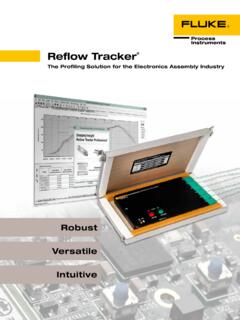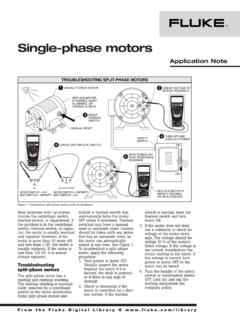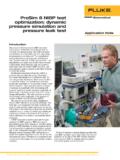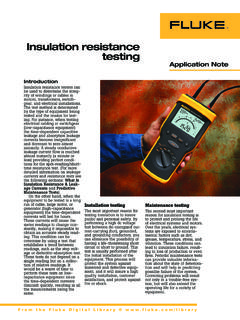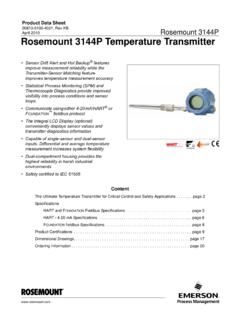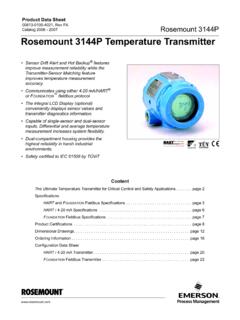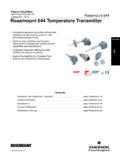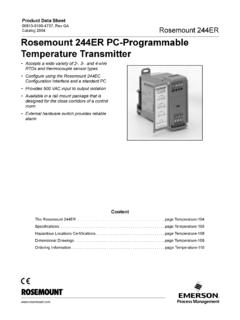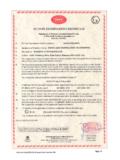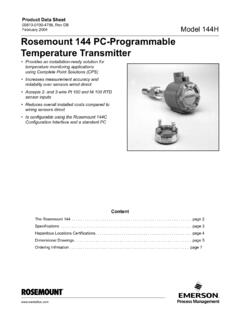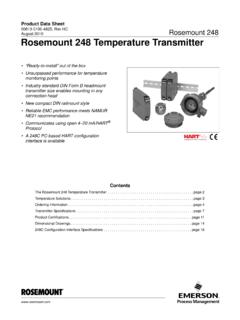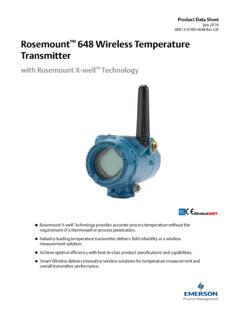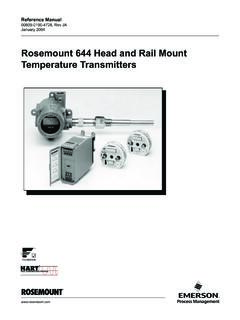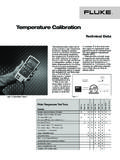Transcription of HART Transmitter Calibration - Fluke Corporation
1 From the Fluke Digital Library @ NoteIntroductionIn today s process plants, most new field instruments are smart digital instruments. Smart implies a microprocessor-based instrument with extra function-ality and digital compensation, supporting multiple sensor types or multiple variables. These instruments generally offer better accuracy, long-term sta-bility, and reliability than con-ventional analog most common class of smart instruments incorpo-rates the hart protocol, with more than five million hart instruments in use in 100,000 plants worldwide. hart , an acronym for Highway Address-able Remote Transducer, is an industry standard that defines the communications protocol between smart field devices and a control system that employs traditional 4-20 mA capabilities are required to properly service hart instru-ments: precision analog source and measure capability and digital communication capabil-ity.
2 Until recently, this required two separate tools, a calibrator and a communicator. Today, the capabilities of those two tools are available in a single hart Documenting Process Calibra-tor that can help you quickly and effectively service hart Transmitter Calibration2 Fluke Corporation Abridged hart Transmitter CalibrationHART Calibration is required!A common misconception is that the accuracy and stability of hart instruments eliminate the need for Calibration . Another misconception is that calibra-tion can be accomplished by re-ranging field instruments using only a hart communicator. Still another misconception is that the control system can remotely calibrate smart instruments.
3 These are not true. All instru-ments drift. Re-ranging with just a communicator is not cali-bration. A precision calibrator or standard is required. Regular performance verification with a calibrator traceable to national standards is necessary due to:1. Shifts in performance of electronic instruments over time, due to exposure of the electronics and the primary sensing element to tempera-ture, humidity, pollutants, vibration, and other field environmental Regulations governing occu-pational safety, consumer safety, and environmental Quality programs such as ISO 9000 standards for all instru-ments that impact product Commercial requirements such as weights, measures, and custody Calibration is also prudent since performance checks will often uncover problems not directly caused by the instrumentation, such as solidified or congealed pressure lines, installation of an incor-rect thermocouple type.
4 Or other errors and Calibration procedure con-sists of a verification (As Found) test, adjustment to within acceptable tolerance if neces-sary, and a final verification (As Left) test if an adjustment has been made. Data from the cali-bration are collected and used to complete a report of calibra-tion, documenting instrument performance over instruments, even hart instruments, must be cali-brated on a regular, preventive maintenance schedule. The Calibration interval should be set short enough to insure that an instrument never drifts out of tolerance, yet long enough to avoid unnecessary calibra-tions. Alternatively, the interval may be determined by critical process requirements, , cali-bration before each are hart instruments properly calibrated?
5 To calibrate a hart instrument consistent with its application, it is very helpful to understand the functional structure of a typical hart Transmitter . hart instruments consist of three distinct sections (see Figure 1). Proper hart calibra-tion may involve either or both sensor trim and output trim. Adjusting range values (LRV and URV) without a calibrator is not Calibration . Performing an output trim while ignoring the input section is not proper Calibration . Adjusting range values with a calibrator may be a practical Calibration alterna-tive for instruments operated in 4-20 mA analog mode, provided that the PV and PVAO are not used for process TrimLRV/ URV AdjustOutput TrimPVPVAO4-20 mAInputSectionConversionSectionOutputSec tionAnalogInput(digitalinput)(digital4-2 0 mA)Analog mA OutputFigure Fluke Corporation Abridged hart Transmitter CalibrationFigure NumberPV(Primary Variable)PVAO(Digital representation of the Primary Variable Analog Output)Analog Measure ValueAnalog Source ValueTag IDPV LRV(Primary VariableLower Range Value)PV URV(Primary VariableUpper Range Value)
6 New tool speeds calibrationToday, instrument maintenance is moving out of the shop and into the field. This reduces process interruptions and avoids the time and expense of returning instruments to the shop. Portable communicators and calibrators are often used together to complete field cali-brations. However, the desire to carry less equipment and to per-form maintenance in the field has created a need for a new class of Calibration tool. The new 754 Documenting Process Calibrator from Fluke is a powerful yet easy-to-use tool for field Calibration of hart instrumentation. Pressing a single key enters the hart mode and displays the essential hart information in the Active Device Screen, shown in Figure 2.
7 Additional hart functional-ity is accessed with only a few more keystrokes, per the menu tree in Figure Fluke Corporation Abridged hart Transmitter CalibrationNo communicator is required!The 754 requires no exter-nal box or communicator for everyday hart Calibration and maintenance. It supports many popular models of hart transmitters, with more device-specific command support than any other hart field calibrator. Interrogate hart devices to determine type, manufac-turer, model, tag-ID, PV, and PVAO Perform automated hart sensor trim and output trim for selected devices Adjust ranging, damping, and other basic process configu-ration settings Read and write hart tag and message fields to re-label smart transmitters Clone additional transmitters with basic hart configura-tion data ProcessSetupServiceAbortDeviceIdentifica tionHARTO utputHARTI nformationBasicSensorLoop testPressurezero trimOutput trimSensor trim Keypad input Adjust URV, LRV to applied valuesDetailed(coriolis)
8 Tag PV units LRV, URV Damping Transfer function Config Sensor Config OutputSensor 1 Sensor serial number Sensor lower and upper limits Sensor minimum span Temperature devices only: Change Sensor Type Change Sensor ConnectionsSensor 2 Change Sensor Type Change Sensor Connections(Dual sensor temperature devices) Dual Sensor Config(Dual sensor temperature devices) Write protect Alarm state hart poll address hart burst mode hart burst command Software Version Final assembly number LRV, URV Damping Transfer function Manufacturer Model Device hart ID Software revision Hardware revision Number of preambles View process variables View variable map Re-map process variables(Dual sensor temperature devices)
9 Figure Fluke Corporation Abridged hart Transmitter CalibrationCalibration of a rosemount 3051 hart Pressure TransmitterBasic connectionsThis example assumes that the Transmitter is isolated from the process and is not electri-cally connected to a loop power supply. Make basic connections to the 3051 per the diagram in Figure 4. A separate 250 ohm resistor is not necessary because the 754 incorporates a resistor in series with the loop supply through its mA jacks. The 3051 in this example is configured for mbar Power on the Fluke 754 Calibrator. Press the red key followed by the Loop Power softkey and the 754 will display the basic hart information for the 3051 (Figure 5).
10 Figure Press the key again and you are prompted to select the 754 configuration (Figure 6). Selecting MEAS mA, SOURCE mbar will configure the calibrator to measure the analog mA output and the pressure being applied simultaneously to the trans-mitter input and the pressure module. (Selecting MEAS PV, SOURCE mbar will config-ure the 754 to evaluate the digital PV output from the Transmitter .) Press to Vent the pressure line and press CLEAR(ZERO) to zero the pres-sure module. Press the As Found softkey, and then press to select Instru-ment for a linear Transmitter Calibration . (If the 3051 is configured for square root output, select Instru-ment.) Notice that the Calibration template is auto-matically completed with the exception of Tolerance.


